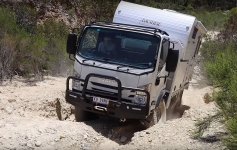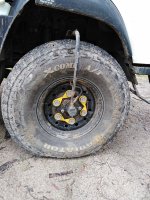Ferjablito
Active member
Hi guys
Does anyone have air suspension on their Fuso? I'm looking at mounting options.
Does anyone have air suspension on their Fuso? I'm looking at mounting options.
Sorry with the translator, I may not have explained myself well, what I want to mount is this type only for road use support.As much as that truck has air bags, I would not really call it air bag suspension; it's more like air bag assist.


First of all, thanks for your comments MickDzIToy, I Just had a thought after reading your take on Isuzu NPR/NPS wheel travel, presumably from an American perspective.
All Terrain Warriors (ATW), essentially take an everything approach, which you can have, or you can have a restricted approach. In 2019, which is when we started talking with ATW, there were various options we could get for the vehicle to do what we wished. Our vehicle, is basically an everything approach.
The original reason we were looking at these units was to place our existing slide-on camper from another vehicle, which after 10 years of sand dunes and corrugations had started to fall apart. Having extra carrying capacity and extra room for whatever we wished to carry was going to be a bonus. It also meant that were weren't right on the legal maximum weight limit as we were with our utility vehicle.
The first question they asked was what terrain we wished to travel over, followed by, "are you wishing to tow?" Understanding that we were going to have a vehicle that was designed for 7500kg as a 4x4 from the factory, but were only going to be running at an estimated 6000kg when fully loaded, the suggestion was put to me that perhaps I would be interested in the 17" wheels fitted with 37" tyres. The complete suspension change, which includes an approximate 50 to 60mm body lift, then allows them to configure this extreme articulation possibility.
The downside of this wheel/tyre suspension combination, was a lowering of the Gross Vehicle Mass (GVM) from 7500kg to 7000kg. In general our GVM is always slightly under 6000kg when fully loaded, so the capability of the vehicle is excellent, not brilliant, but certainly has allowed us to travel to some interesting places with relative ease.
As a point of interest, we sometimes run fuel and water quite low, the difference over a weighbridge which happened to be handy once as we did a there and back 15 day trip, was approximately 460kg lighter. Having CTIS fitted to the vehicle allows us to adjust or trim the front and rear axle air pressures to accommodate the change in GVM, which is something we never would have thought of prior to having the CTIS fitted. After refuelling and taking on water, we just press a couple of buttons and we are back to correct pressure for the changed GVM.
Without the body lift, I doubt very much you could still have 600mm of articulation with tyres that are 940mm high by 340mm wide. It really is a marvel how they've done that. So this vehicle is certainly very different to a stock NPS, and way different to the NPR in Australia.
In Australia out of the three Japanese 4x4 light trucks that are available, Canter, NPS and Hino, the Canter is the smallest/lightest and most nimble. The Isuzu 75/155 is larger in most aspects over the Canter and only comes with a single wheelbase option (medium). The Hino is the largest of the three, has unbelievable brakes (all disc) but is almost unseen in this country. I've only ever seen one Hino, a crew cab unit, and that belongs to a niece and her husband and their 4 kids.
Mick.
It's probably a translation thing, but what is tyre extension?tire extension
It may be the translatorIt's probably a translation thing, but what is tyre extension?
